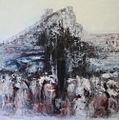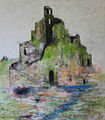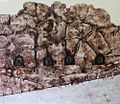İbrahim Coşkun
The artist Ibrahim Coşkun , born in 1955 in Tunceli , Turkey , belongs to a Turkish minority called Kırmanc. The focus of his work is the age-old tragic history of this ethnic group and the unique landscape of their homeland in Anatolia, heavy with memories.
Life
In 1970 İbrahim left Turkey for Germany, where he studied painting and photography at the private Paris Art Academy in Hamburg. Between 1980 and 1984 he learned from Professor Fred Thieler in Berlin, who at that time was teaching informal painting at the Hochschule der Künste, today's Berlin University of the Arts.
After a trip to Turkey, İbrahim was banned from leaving the country in 1984, so that he could not return to Germany for the time being. In 1987 in Ankara he became a founding member of the Turkey Human Rights Association (İnsan Hakları Derneği). In 1989 he fled Turkey and was received in Germany by Willy Brandt, who had dealt with his fate at the time. From 1989 to 2001 he continued his artistic activity in Bielefeld.
İbrahim has lived and worked in Berlin since 2002. From 2011 to 2014 he worked as an art lecturer at a German high school. He is currently working as a freelance artist in Berlin, Istanbul and Bodrum .
Artistic creation
The works of İbrahim Coşkun are highly valued by several art historians. Tayfun Belgin (director of the Osthaus Museum Hagen), one of the leading art historians in Europe, has accompanied İbrahim Coşkun for over 20 years and has already published two books with selected works: "Traces" in 2000 and "Petrified Songs" in 2015. Tayfun Belgin writes about İbrahim Coşkun:
"İbrahim is a fighter with color. All expressive works that follow an objectivity are presented as images that have been achieved in a spiritual and emotional process. Without question, all works reveal an emotional dimension that is second to none. İbrahim prefers Impasto and at the same time contracting colors. The colors determine a world of images that can be defined abstractly and expressively. We also find such images with him, works that have no direct reference to an object or motif. When he uses his inner colors and impasto Acting on the canvas, he creates worlds that western painting in the contemporary art context is not familiar with. These pictures have a biographical matrix. They are the essence of an inner world that can gradually penetrate the outside world.
At the same time, İbrahim creates landscape paintings that go well beyond the classic genre of landscape painting. "Landscape" here is also a landscape of emotions in the best sense of the word. Landscape denotes the ground, but also memory. We often see strong breaks in the landscape. There are therefore no ostensibly romantic landscape motifs that we encounter in this painting. Landscape is home, at the same time a record of that emotional break that was caused by military operations. Many people returned to their former homeland after decades of war and found a contaminated environment. İbrahim not only speaks for himself when he shapes this barren landscape with the aftermath of the war into an aesthetically manageable world. The experiences of others find their way into this world of images subcutaneously. "
Solo exhibitions (selection)
Since 1984 İbrahim has had numerous national and international exhibitions, including a. in Schweinfurt, Mersin (Turkey), Adana (Turkey), Bielefeld, Düsseldorf, Luxembourg, Brussels, Istanbul, Ankara and Berlin.
- 1999 Gallery of the State Parliament of North Rhine-Westphalia, Düsseldorf
- 2000 Galerie Fischer, Berlin
- 2001 Gallery of the Ministry of Culture Turkey, Istanbul
- 2004 Tammen and Busch Gallery, Berlin
- 2005 Herne State Museum, Herne
- 2007 UNESCO Culture Days Basel
- 2008 Gallery in the Verdi House, Berlin
- 2010 Robert Koch Institute, Berlin
- 2012 Solitaire Gallery Berlin
- 2013 Gallery of the State Parliament of North Rhine-Westphalia, Düsseldorf
- 2015 "ART vision" by Otto Nagel, UNIQ Istanbul
Works
Works from the series "Erdspuren"
The freelance journalist and author Birgit Kahle writes in the foreword about the "Erdspuren", to which an entire catalog has been dedicated :
Ibrahim Coskun calls his works, created between 1997 and 1999, “» Earth Pictures «. That is his very personal working title, hardly any of his works officially have a name. "Like back then, in my childhood, I am looking for the structures of the earth, for what it is keeping secret from me." Every now and then he succeeds in deciphering one of these riddles. Then the term “earth” takes on a haptic quality on the canvas, becomes three-dimensional, lively. A vortex of longings opens up to the viewer, whose strongest pull is a desire to touch. Sensing that beneath the grace of the colors lies another, metaphysical treasure. "
Last but not least, Birgit Kahle emphasizes the “political status quo” of the works: “Depopulated villages, orphaned houses - Coskun outlines a Kurdistan that, if the situation does not change, will only be home to ghost towns. Ruins of stone and petrified homeless souls. Fed up with potential for hate for countless generations. ”This diagnosis, it must be said, is more relevant today than ever!
Works from the series "traces of color"
Works from the series "Petrified Songs"
The art historian Tayfun Belgin on the "Petrified Songs":
"In addition to the architectural images, which mostly show ancient ruins or the remains of architectural ensembles seen through a haze of fog, we find works that are intensively dedicated to the once preferred building material of this region: the stones. They look like large stone figures that have lost their language and Looking at us viewers questioningly, apparently they are petrified utterances. It is a small emotional step on our part to sense a historical cosmos in these stone sculptures, which relates to the long, at times of great suffering, Anatolian life. A blues that today still has an impact, in language, in music, in everyday life. "
literature
- Traces. Ibrahim Coṣkun . Kerber, Bielefeld 2000, ISBN 3-933040-44-2
- İbrahim Coşkun - Petrified Songs , ed. v. Tayfun Belgin, Berlin 2015. ISBN 978-3-00-049962-3
Web links
Individual evidence
- ↑ İbrahim Coşkun - traces, ed. Tayfun Belgin and Birgit Kahle, Bielefeld 2000.
- ↑ İbrahim Coşkun - Petrified Songs, ed. v. Tayfun Belgin, Berlin 2015. ISBN 978-3-00-049962-3
- ↑ İbrahim Coşkun - Petrified Songs, ed. v. Tayfun Belgin, Berlin 2015, p. 13f. ISBN 978-3-00-049962-3
- ↑ Preface, in: İbrahim Coşkun - traces, ed. v. Tayfun Belgin and Birgit Kahle, Bielefeld (Kerber Verlag) 2000. ISBN 3-933040-44-2
- ↑ Preface, in: İbrahim Coşkun - traces, ed. v. Tayfun Belgin and Birgit Kahle, Bielefeld (Kerber Verlag) 2000. ISBN 3-933040-44-2
- ^ Foreword, in: Petrified songs. İbrahim Coşkun, ed. v. Tayfun Belgin, Berlin (Motiv Verlag) 2015. ISBN 978-3-00-049962-3
| personal data | |
|---|---|
| SURNAME | Coşkun, İbrahim |
| ALTERNATIVE NAMES | Coşkun, Ibrahim |
| BRIEF DESCRIPTION | Turkish artist |
| DATE OF BIRTH | 1955 |
| PLACE OF BIRTH | Tunceli |















